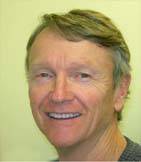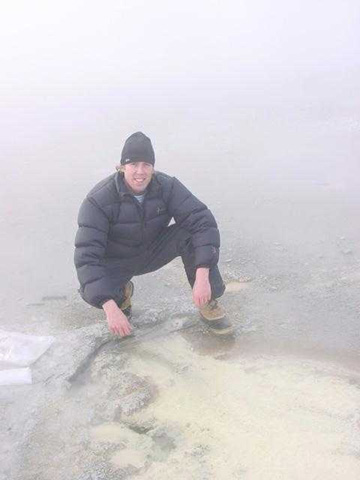Gill Geesey, Ph.D., Professor
 Microbiology & Immunology
Office: 109 Lewis Hall
Microbiology & Immunology
Office: 109 Lewis Hall Phone: 406-994-382 Email: [email protected]
RESEARCH OVERVIEW
Biological Elemental Sulfur Reduction. Sulfur is a ubiquitous element in thermal areas of Yellowstone National Park. A casual examination of many thermal features in the Park reveals a white-to-yellow-colored material coating the surfaces of springs, pools and soils that is most likely elemental sulfur. While much is know about the formation of elemental sulfur through chemical and biological reactions, little is known about the fate of elemental sulfur in these extreme environments. Our research focuses on the use of elemental sulfur as a substrate for anaerobic respiration by thermophilic archaea in Dragon Spring in the Norris Geyser Basin. Two archaea in the kingdom Chrenarcheota have been isolated from sulfur flocs deposited at the source of Dragon Spring as a result of abiotic oxidation of hydrogen sulfide gas in the source water upon exposure to the atmosphere (Boyd et al, 2007). In the laboratory, these Chrenarchaeal isolates use the sulfur flocs as a terminal electron acceptor during growth on complex organic carbon compounds such as pine needle extract, peptone, tryptone, or yeast extract, producing hydrogen sulfide as a product of respiration. The isolates appear to be well adapted to the spring environment with an optimum temperature and pH for growth close to that which exist in the source water. One important question related to elemental sulfur reduction that remains to be resolved is how these microbes transfer electrons from their cell surface to the solid or colloidal phase sulfur. Isolate-specific primers have been constructed to facilitate detection of these organisms elsewhere in the Park.
CO2 Uptake and Fixation by a Thermoacidophilic Microbial Community Attached to Precipitated
Sulfur in a Geothermal Spring.
Carbon fixation at temperatures above 72oC, the upper limit for photosynthesis, is
mediated by chemosynthetic thermophiles. Yellowstone National Park (YNP), Wyoming
possesses many thermal features that while too hot for photosynthesis, support chemosynthetic-based
carbon fixation. However, in situ chemosynthetic activity measurements at these temperatures
are generally lacking in these systems. A microbial community attached to precipitated
elemental sulfur at the source of an acidic spring (73°C, pH 3.1) in YNP, exhibited
a CO2 uptake rate in situ of 193+13 µg C µg DNA-1 h-1. This rate is comparable to that
calculated for a photosynthetic mat microbial community dominated by Synechococcus spp. at temperatures approaching this upper limit for photosynthesis in alkaline
springs. A portion of the carbon taken up as CO2 by the sulfur-associated microbial community was recovered in the cellular nucleic
acid pool, demonstrating that uptake was coupled to fixation. The microbial community
was dominated by Hydrogenobaculum spp. based on relative abundance of clones recovered from a 16S rRNA clone library.
The only non-Hydrogenobaculum 16S rRNA sequence recovered from the community in this study was most closely related
to Thermocladium, a crenarchaeote capable of mixotrophic metabolism. Other Crenarchaea populations
isolated from the same community in a previous study took up CO2 under conditions that supported mixotrophic metabolism in the present study. While
it is likely that the bulk of the community CO2 uptake reported in the present study was mediated by chemosynthetic Hydrogenobaculum spp., a portion may have been coupled to mixotrophic growth by crenarchaeal populations
present.
Microbial Mats as a Pathway for Bioaccumulation of Monomethyl-Mercury in a Thermal Area Aquatic Food Web. Mercury (Hg) occurs naturally in various forms in the soil and water of thermal areas of Yellowstone National Park. Hg(II) in spring water is transformed to monomethylated Hg (MeHg) by microbial populations associated with mats of the green alga Zygogonium in a number of acidic springs within the Park. Our research has found that larvae of a soldier fly species (Diptera:Stratiomyidae) selective graze specific populations of several algae within the mat community. This grazing behavior results in elevated levels of MeHg in the gut and tissues of the larvae. Future research will be directed to the investigation of further biomagnification of MeHg in avian populations in the area that feed on the insect larvae, and identification and characterization of the microorganisms that mediate the methylation reaction.
SELECTED PUBLICATIONS
CO(2) uptake and fixation by a thermoacidophilic microbial community attached to precipitated
sulfur in a geothermal spring.
Boyd ES, Leavitt WD, Geesey GG. Appl Environ Microbiol. 2009 Jul;75(13):4289-96. Epub 2009 May 8
Methylmercury enters an aquatic food web through acidophilic microbial mats in Yellowstone
National Park, Wyoming.
Boyd ES, King S, Tomberlin JK, Nordstrom DK, Krabbenhoft DP, Barkay T, Geesey GG. Environ Microbiol. 2009 Apr;11(4):950-9. Epub 2008 Dec 17.
CURRENT LAB PERSONNEL
Matt Urschel, Ph.D. Student,[email protected]

Graduate student Eric Boyd at the Geesey lab sample site
COLLABORATORS
Tamar Barkay,Department of Biochemistry and Microbiology, Rutgers University
Tanja Bosak,
Department of Earth, Atmospheric and Planetary Sciences, Massachusetts Institute of Technology
Sarah Boomer,
Department of Biology, Western Oregon University
D. Kirk Nordstrom,
USGS, Boulder, CO
David. P. Karbbenhoft,
USGS, Madison, WI
Jeff Tomberlin,
Department of Entomology, Texas A&M University
